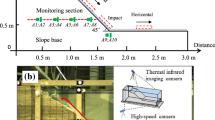Summary
According to the combined effects of various parameters the displacement of large masses by gravitation may assume different forms, each characterized by certain basic mechanisms. The present state of knowledge does not allow an exhaustive description of the conditions under which flowing, rolling, bouncing or sliding may be expected. This is one of the reasons for the obvious lack of accuracy in predicting the range threatened by an impending event. Catastrophes like those of Longarone and Yungay show the importance of sufficiently wellfounded mathematical models.
Such models have to be based on the fact that from all possible mechanisms the one with the smallest energy consumption has normally the best chance of being automatically selected.
In the course of the last decade, however, certain improvements have been obtained for the case of large landslides. In particular it could be shown that voluminous masses of rock are displaced in first instance by gliding and that self-lubrication effects are at least very probable. These effects are fundamentally different for primitive rock and carbonate, but in both cases they are due to frictional heat. The lubricant is fused material for primitive rock and a cushion of carbonic acid for carbonate. The results are backed both by field evidence and experimental simulation. In particular, an explanation is given for the hitherto enigmatic size effect (economy improving in function of volume).
Similar content being viewed by others
References
Bagnold, R. A.: Experiments on a gravity-free dispersion of large solid spheres in a Newton fluid under shear. Proc. R. Soc. Lond.A225, 49–63 (1954).
Bagnold, R. A.: The flow of cohesionless grains in fluids. Proc. R. Soc. Lond.A249, 235–297 (1955).
Eisbacher, G. H.: Cliff collapse and rock avalanches (Sturzstroms) in the Mackenzie Mountains, Northwestern Canada. Canadian Geotechnical Journal16, 309–334 (1979).
Erismann, T. H., Heuberger, H., Preuss, E.: Der Bimsstein von Köfels (Tirol), ein Bergsturz-”Friktionit”. TMPM24, 67–119 (1977).
Erismann, T. H.: Mechanisms of large landslides. Rock Mechanics12, 15–46 (1979).
Erismann, T. H.: Der Gefahrenbereich großer Bergstürze, in: EMPA 1980–1990, Dübendorf 1980.
Heim, A.: Bergsturz und Menschenleben. Zürich: Fretz & Wasmuth 1932.
Heuberger, H., Masch, L., Preuss, E., Schröcker, A.: Quaternary landslides and rock fusion in central Nepal and in the Tyrolean alps. Mountain R. & D.4, 345–362 (1984.)
Körner, H. J.: Zur Mechanik der Bergsturzströme vom Huascarán, Peru. Hochgebirgsforschung, Heft 6, 71–110 (1983).
Masch, L., Preuss, E.: Rocks and rock formation in an example of frictional fusion on a thrust plane in the Langtang Himal, Nepal. IMA-Meeting 1974. Collected Abstracts 193, 1974.
Preuss, E.: Über den Bimsstein von Köfels/Tirol. Fortschr. Min. 49, Beiheft 1, 70 (1971).
Shreve, R. L.: The blackhawk landslide. Univ. Calif. Special Paper No. 108, 1968.
Author information
Authors and Affiliations
Additional information
With 7 Figures
Rights and permissions
About this article
Cite this article
Erismann, T.H. Flowing, rolling, bouncing, sliding: Synopsis of basic mechanisms. Acta Mechanica 64, 101–110 (1986). https://doi.org/10.1007/BF01180101
Received:
Revised:
Issue Date:
DOI: https://doi.org/10.1007/BF01180101




